Sea-ice research at the Max Planck Institute for Meteorology and the Universität Hamburg
The Sea Ice Physics laboratory of the Max Planck Institute for Meteorology is located at the Universität Hamburg and driven in close collaboration between the Max Planck Institute and the university. Using the facilities of the laboratory our sea ice research group at the Institute of Oceanography under the direction of Prof. Dr. Dirk Notz combines theory and observations to obtain a robust understanding of sea-ice physics. We are working on different scales, from microscale intrinsic properties of sea ice, like brine channels, to global changes in sea ice and drivers of sea-ice coverage.
The sea-ice laboratory is used both for education and for research. Research projects, including study projects and thesis are focused on fundamental aspects of sea-ice physics, sea-ice biogeochemistry and air-ice-sea interaction under a wide range of controlled environmental conditions. Repeatable and replicable experiments yield evaluation data for model simulations. Moreover, the laboratory is used as a testing and calibration facility for new measurements methods and instrument developments.
Facility description
The ice chamber consists of a walk-in cold room with two water tanks which serve for producing ice under controlled conditions: A large glass tank of 1.2 m³ that is used for growing sea ice with realistic vertical properties. The tank is cooled at the water surface by energy exchange with the circulating air in the freezing chamber, comparable to the conditions in polar regions. By controlling the temperature of the cold room, we can simulate for example a seasonal cycle of growing and melting sea ice. A small transparent plastic tank for those small-scale process studies that require high accuracy in the prescribed environmental conditions. The tank can be cooled and heated from below to produce ice that is growing from bottom to top. This setup allows us to grow synthetic sea ice with a specific bulk salinity.
The atmospheric and oceanic forcing of ice growth in the different experimental set-ups can be adjusted very flexibly, including the evolution of air temperature, water salinity, atmospheric composition, oceanic heat flux, illumination, and water motion. In the small tank, the temperature at the ice bottom can be controlled with an accuracy of 0.01K, which allows us to precisely determine the heat conduction in the ice. For the experiments, we can cover a temperature range of:
- Cold room: -25°C to about +20°C (cooling only)
- Contact cooling plate small tank: -50°C to +40°C (cooling and heating)
In the ice laboratory, a wide range of equipment is available for manipulating and exploring the ice. We particularly focus on automatic monitoring systems that continuously record data without destructively altering the ice. The standard monitoring system covers basic atmospheric properties as air temperature and humidity, sea-ice profile measurements of temperature and salinity and oceanographic measurements of salinity and sea temperature.
Tanks
The ice chamber consists of a walk-in cold room with two water tanks which serve for producing ice under controlled conditions:
A large glass tank of 1.2 m³ that is used for growing sea ice with realistic vertical properties. The tank is cooled at the water surface by energy exchange with the circulating air in the freezing chamber, comparable to the conditions in polar regions. By controlling the temperature of the cold room, we can simulate for example a seasonal cycle of growing and melting sea ice.
A small transparent plastic tank for those small-scale process studies that require high accuracy in the prescribed environmental conditions. The tank can be cooled and heated from below to produce ice that is growing from bottom to top. This setup allows us to grow synthetic sea ice with a specific bulk salinity.
Cooling chamber & Ice formation
The atmospheric and oceanic forcing of ice growth in the different experimental set-ups can be adjusted very flexibly, including the evolution of air temperature, water salinity, atmospheric composition, oceanic heat flux, illumination, and water motion. In the small tank, the temperature at the ice bottom can be controlled with an accuracy of 0.01K, which allows us to precisely determine the heat conduction in the ice.
For the experiments, we can cover a temperature range of:
- Cold room: -25°C to about +20°C (cooling only)
- Contact cooling plate small tank: -50°C to +40°C (cooling and heating)
Standard measurements / instrumentation/ infrastructure
In the ice laboratory, a wide range of equipment is available for manipulating and exploring the ice. We particularly focus on automatic monitoring systems that continuously record data without destructively altering the ice. The standard monitoring system covers basic atmospheric properties as air temperature and humidity, sea-ice profile measurements of temperature and salinity and oceanographic measurements of salinity and sea temperature.
Selected projects of the past
Here, we present a selection of projects that have been conducted in the ice lab in the past.
This comprises mainly Bachelor and Master thesis.
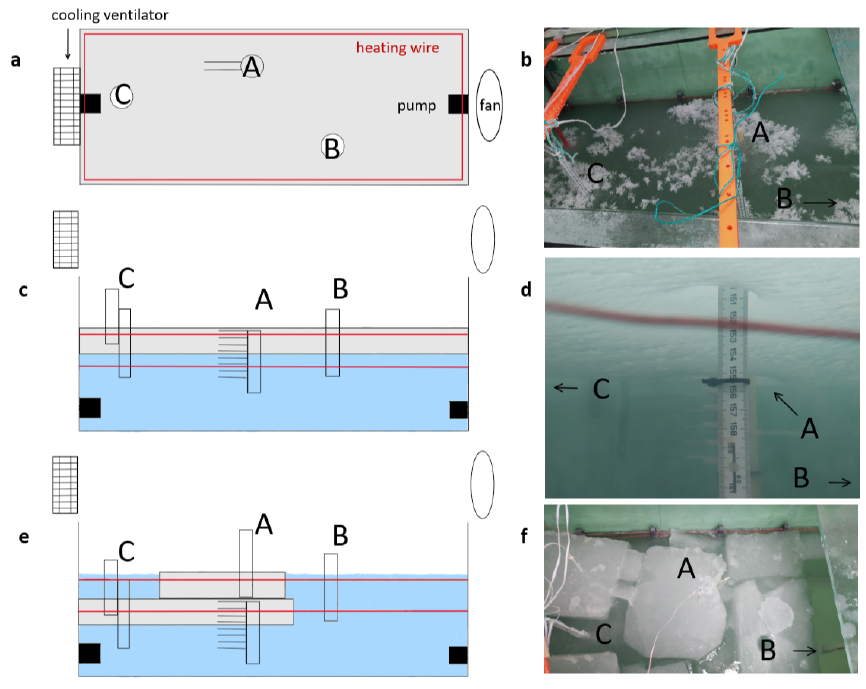
Ice floe rafting
In this study I investigate whether the ice-thickness redistribution from a rafting process and the resulting ice-thickness development has a positive or negative impact on the overall sea-ice volume. This information could become increasingly important in the future for the prediction of sea-ice thickness and volume, as climate change promotes the occurrence of thin one-year ice, which, in comparison to multiyear-ice, is more likely to raft. I approached this topic by rafting ice floes of equal thickness in a tank experiment andW tracking the sea ice thickness and temperature evolution vertically in the ice in three distinct areas across the tank.– Lea Nupnau (former Bachelor student)
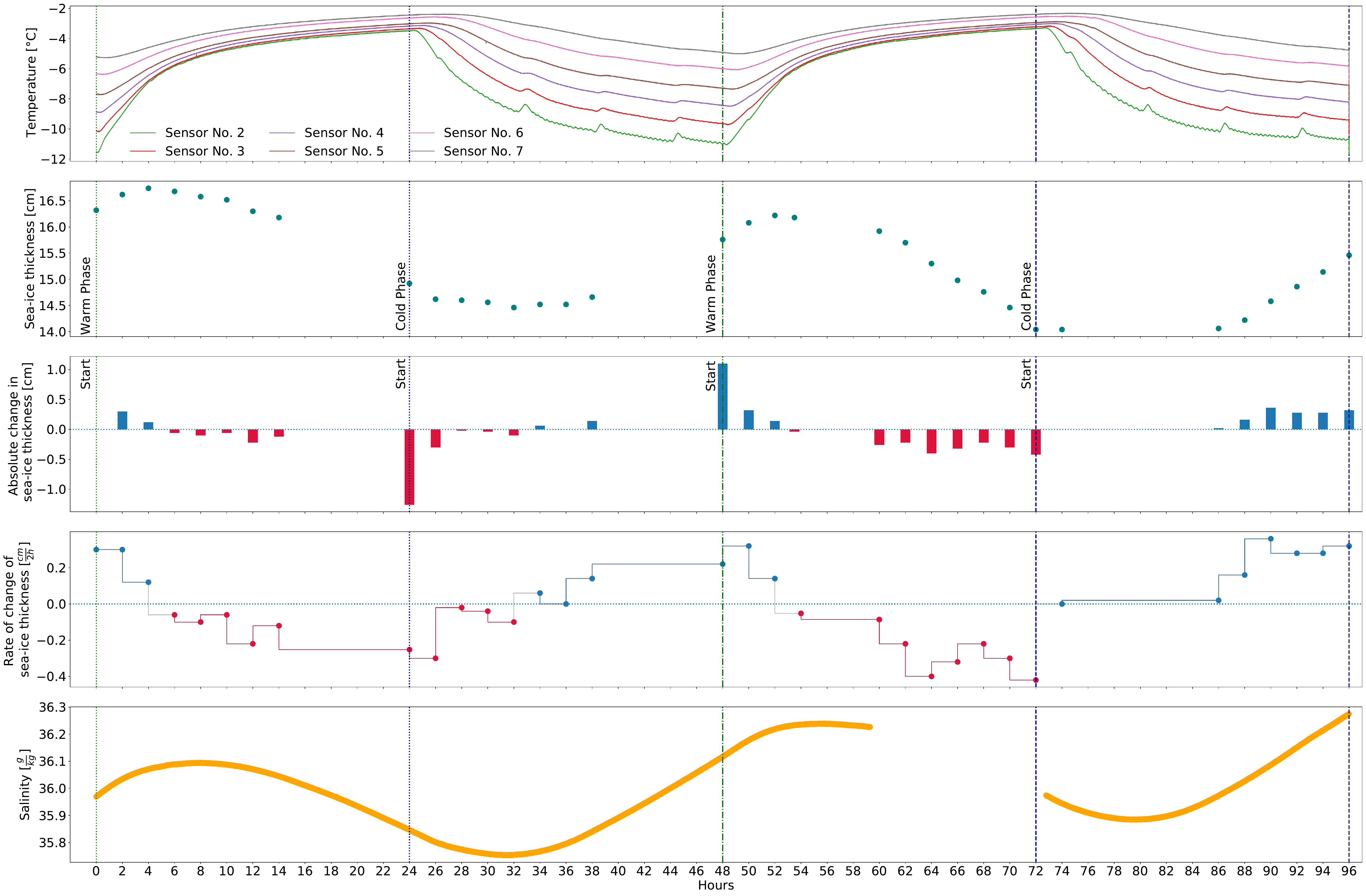
Heatwaves' Impact on Sea Ice Growth
In this Bachelor thesis, I conducted two 96-hour experiments in the sea-ice laboratory. They focused on the impact of heatwaves on sea-ice growth. Experiment one had two 24-hour heatwaves, while experiment two consisted of a continuous 48-hour heatwave. Each heatwave was preceded by a 24-hour cold phase. I simulated the heatwaves by adjusting the cooling chamber's temperature to -2°C, slightly below freezing, and then resetting it to -20°C for the cold phase. To analyze temperature shifts, I deployed a salinity harp, several temperature sensors and rulers in the ice and used a CTD in the water. The data collected, including air, water, and ice temperatures, salinity values, and changes in the ice cover, revealed that two short heatwaves have a greater negative impact on sea ice growth compared to one long heatwave. Additionally, repeated melting resulted in a more porous ice cover structure.– Dana King (former Bachelor student)
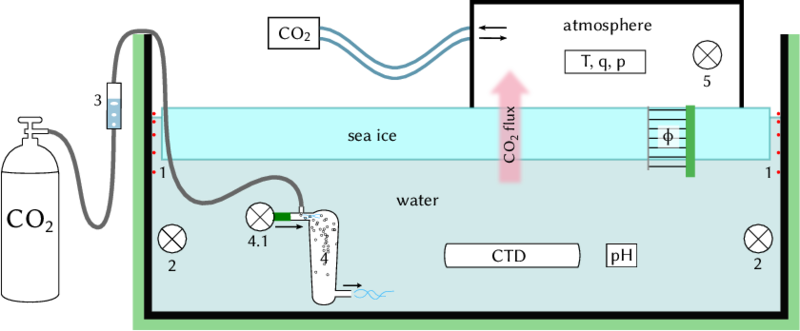
CO2 diffusion through sea ice
As a major part of this work, an experimental setup has been developed to perform a laboratory study on two research questions: (1) The transport of dissolved CO2 with sinking water masses due to brine rejection (this is known as the sea-ice carbon pump, SICP). (2) A second experiment shows that a significant amount of CO2 actually diffuses through sea ice– Markus Ritschel (former Master student)
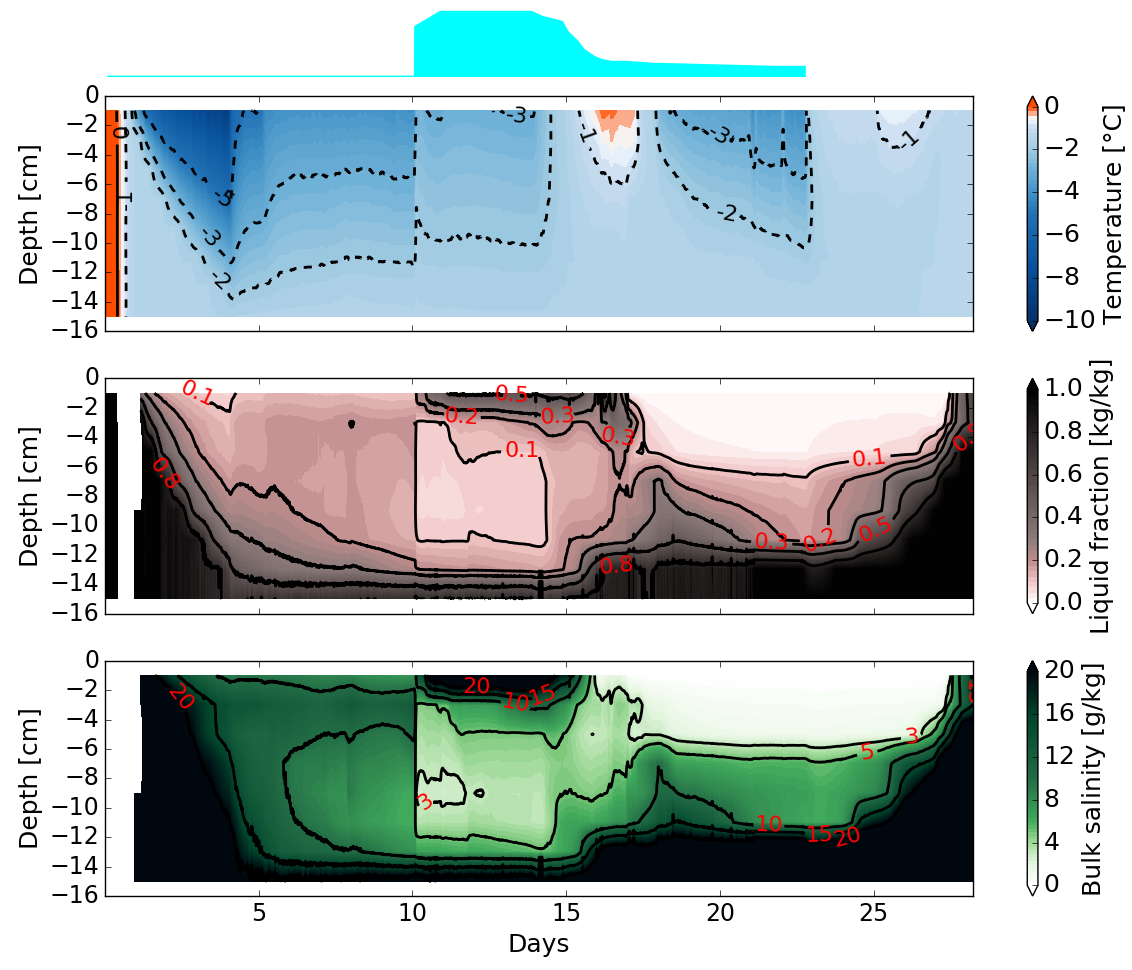
The impact of snow on sea-ice salinity
Desalination processes beneath snow: In my Master's thesis in 2016/2017, I investigated how melting freshwater from snow affects the salinity of the underlying sea ice. I simulated entire annual cycles of Arctic sea ice in 4 weeks in the large tank in the laboratory. The graph shows vertically resolved time series of temperature, solid ice fraction and salinity in the ice, recorded with our measuring device Salt Harp. Parallel to snow melt, the salinity in the ice decreased strongly compared to measurements without snow. The results confirmed the theory of freshwater flushing and led to an improved implementation of the processes in the 1-D sea ice model SAMSIM.– Niels Fuchs
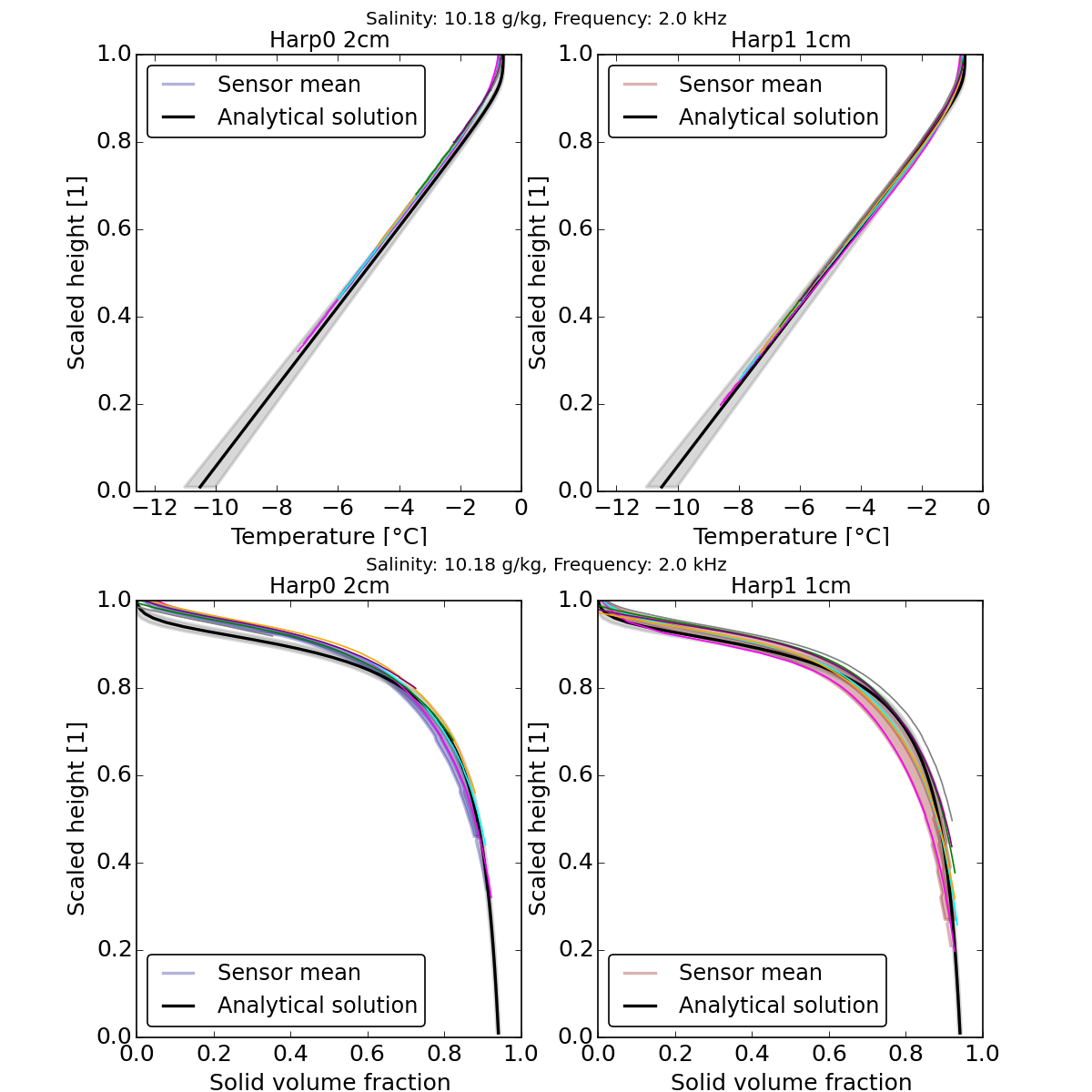
Salt harp reference measurements
As part of the in-house development of measuring instruments, regular test and calibration experiments are carried out in the small tank. Shown here are results of reference experiments conducted in 2016 to evaluate the newly developed salt harp designs (left: 2cm vertical resolution, right: 1cm vertical resolution). The upper two graphs show the temperature profile in the ice, the lower two the solid ice fraction - derived from the conductivity of the ice. An analytical solution based on Notz (2005) serves as a comparison. It is capable of calculating both profiles accurately, assuming that no desalination processes reduce the salinity of the ice. We can meet this requirement in the small tank, in which the ice grows from the bottom to the top through systematic cooling.– Niels Fuchs
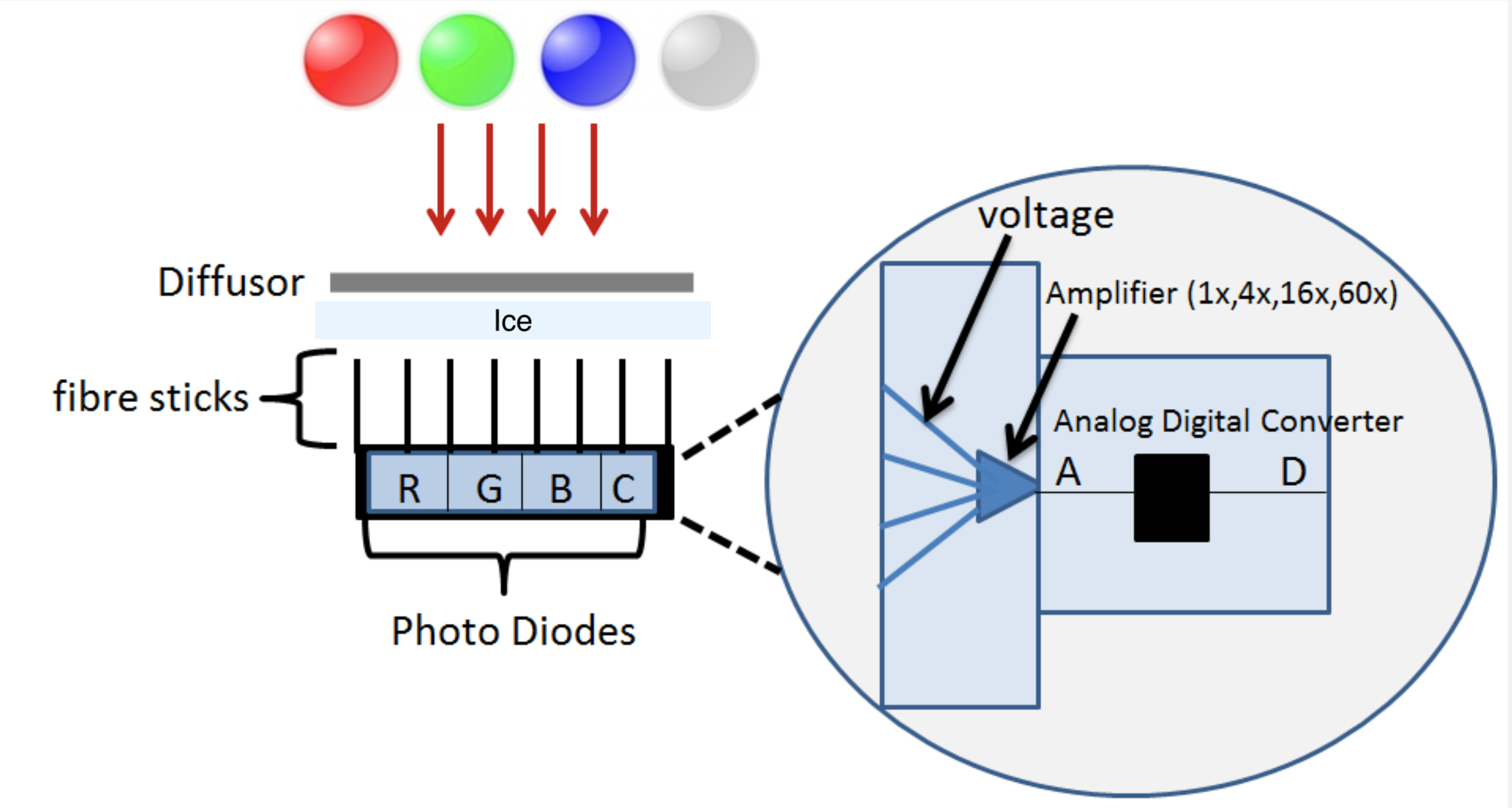
Light penetration through sea ice
The diffuse attenuation coefficient 𝜅 describes the absorption of short wave radiation in the ice, which is triggered by scattering and absorption. 𝜅 in sea ice is strongly depth-dependent and changes with physical ice properties. In models, 𝜅 is nevertheless often parameterized as constant, based on measurements from Arctic field campaigns. These mostly took place on thick, accessible ice. The laboratory allows us to measure light transmission in thin layers of ice. For my Master project, we installed a newly developped multi-band light sensor into the large tank and measured the light decay from above the ice to below. I found significantly higher values for the diffuse attenuation coefficient 𝜅 in thin ice, than the ones implemented in models. Hence, models possibly underestimate the attenuation of light.– Bonnie Raffel (former Master student)
